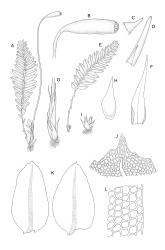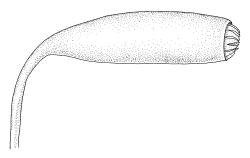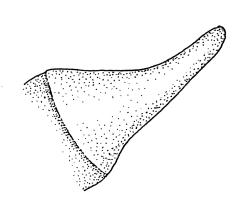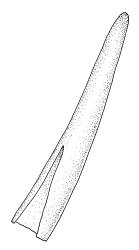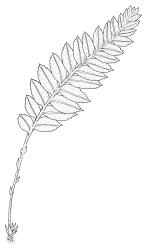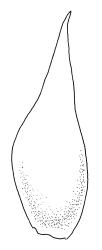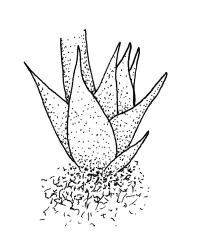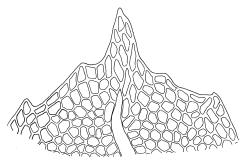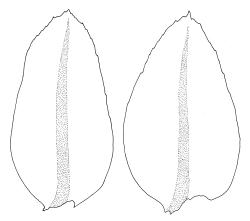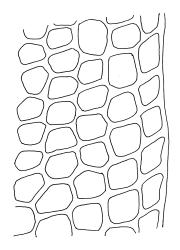- ≡ Hypnum distichum Sw., J. Bot. (Schrader) 1800(2): 179, pl. 3, fig. A (1801)
Plants medium-sized, dull green, forming turves. Stems prostrate, unbranched, dull green above, usually red-brown near base, c. (8–)15–25 mm, in cross-section elliptic, with 3–5 layers of very thick-walled cortical cells surrounding parenchyma cells and a large, flattened central strand, beset at base with bright red-brown, smooth rhizoids. Shoots to 4 mm wide, strongly complanate. Leaves distichous, spreading, asymmetric at base, oblong-ovate with a broadly acute or obtuse apex, not or very weakly concave, variably decurrent, unbordered, dentate above with few to numerous, broadly acute or obtuse, mostly multicellular teeth, (1.8–)2.2–2.6 × 0.9–1.2 mm, becoming much smaller and scale-like near stem base. Upper laminal cells thick-walled, ± hexagonal but ± irregular in shape and size, 0.5–2:1, at least some cells >18 µm in greater dimension, often more regular and ± quadrate or oblate towards margins, becoming elongate at extreme base, alar cells and marginal cells not differentiated. Costa broad (c. 120–200 µm) near base, uniformly tapered (c. 100–125 µm at mid leaf) and terminating several cells below the leaf apex, in cross section (at mid leaf) biconvex, with a central layer of guide cells, and elongate (3–6:1) superficial cells.
Dioicous. Perichaetia in clusters at base of stem, with leaves lanceolate, costate, c. 2 mm (but apparently lengthening after fertilisation to c. 3 mm). Perigonia dark brown and budlike, single at base of stem or numerous and scattered on stem, with bracts c. 1.2 mm, ecostate, acute from an ovate and concave base, with filiform, 5–7-celled paraphyses. Setae 20–35 mm, straight, smooth, twisting weakly to the left, pale brown; capsules horizontal or pendent, oblong-cylindric from a slightly asymmetric base, 2.0–3.5 mm, smooth and not or weakly constricted below the mouth when dry, pale yellow-brown, dark brown at mouth; exothecial cells irregular, mostly oblong-hexagonal or quadrate, 1–3:1 with firm walls, finely and irregularly striate; annulus not clearly observed; operculum rostrate from a conic base, c. 1 mm. Exostome teeth pale yellow-brown, narrowly lanceolate, inserted c. 60 µm beneath the rim, c. 500 µm long, bordered, outer surface finely papillose (non-striolate) below, more coarsely so above, inner surface lamellate; endostome pale, with high basal membrane; segments nearly as long as the teeth, keeled but not perforate, papillose-baculate; cilia in groups of (2–)3, nodose, finely baculate. Calyptra cucullate, c. 3 mm, smooth. Spores ± spherical, 15–19 µm, pale brown, finely papillose.
Malcolm & Malcolm 2003, p. 59; Meagher & Fuhrer 2003, p. 47; Gilmore 2006, pl. 53.
In a N.Z. context, R. distichum is unlikely to be mistaken for anything else. Rhizogonium graeffeanum of Australia and southeast Asia is similar but differs by having costae that are narrower, not dilated at their base, and percurrent to short excurrent.
It is possible that R. lamii Reimers (see Koponen et al. 1986) from P.N.G. is a form of R. distichum, but no material from there has been available for comparison. Koponen et al. (1986, p. 21) considered the occurrence of R. distichum in P.N.G. to be "highly unlikely". If these names were shown to be taxonomically synonymous, R. distichum would have priority.
NI: N Auckland, including offshore islands (LB), S Auckland (including Mayor I.), Gisborne, Hawke’s Bay, Taranaki, Wellington. SI: Nelson, Marlborough, Canterbury, Westland, Otago, Southland; St; Sol; A.
Australasian. Tasmania*, mainland Australia*. A report by Bartram (1945) of this species from P.N.G. was rejected by Koponen et al. (1986). Scott & Stone (1976) recorded this species from southeast Asia, without detail.
Primarily on rotten logs, humic soil (occasionally thin and over rock), less commonly on tree or tree-fern trunks in a variety of forest types. Ranging from c. 60 m (Logue’s Bush Scenic Reserve, N Auckland L.D.) to c. 1200 m (Mt Taranaki, Taranaki L.D.) on North I; near sea level (numerous localities including Punakaikī, Nelson L.D. and Papatōwai, Otago L.D.) to at least 1100 m (Mt Mytton and Flora Saddle, both Nelson L.D.) on South I.
Perigonia are only infrequently observed, which is surprising given the frequent occurrence of capsules.
Holotype material has not been seen, but could be searched for in the Swartz herbarium at UPS. If no appropriate material is present there, one of the duplicates of A. Menzies 89 in BM would be an appropriate lectotype. One of two duplicates in herb. Hooker bears the more complete collection data; the other bears "New Zealand, Mr Menzies" and a citation of Swartz’s protologue. The duplicate in herb. Wilson bears "Dusky Bay, Menzies 89" and the herbarium number "H(ooker) 3313".




